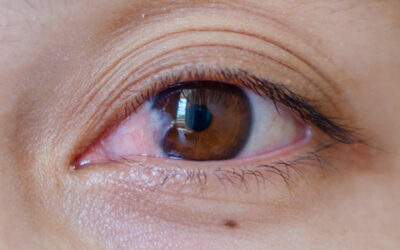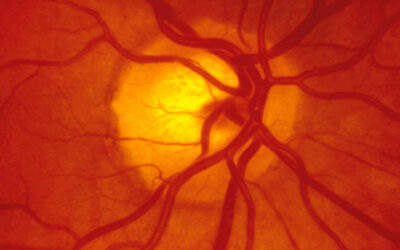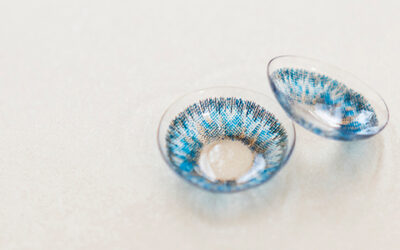Can You Pop An Eyelid Pimple?

It’s common to want to pop a pimple, but if we have something that looks like a pimple in or around our eye area, it’s important to resist popping it at all costs. Chances are that although the eyelid bump looks like a pimple, it’s more likely to either be an infection called a stye, a blocked gland known as a chalazion, or xanthelasma – harmless yellow bumps that are created when fats build up underneath our skin.
Trying to pop one of these bumps is likely to result in it not going away, and instead becoming more uncomfortable and prominent. In some cases, it can also lead to complications like infection, swelling, scarring, or injury to the delicate eye area, which lengthens the healing process.
Styes
A stye is the most common type of eyelid bump we see, particularly in adults aged between 30-50 years*. A stye is a small red bump, often filled with pus, that forms on the outside edge of the eyelid, at the base of the eyelashes, or even inside the eyelid itself.
Our eyelids contain a large number of tiny glands that work to keep our eyes healthy, and styes are usually caused by an infection within one of these glands*. When a gland gets blocked or clogged by dead skin, dirt, or oil buildup, this can cause bacteria to multiply inside, and the gland can become infected, triggering pain, swelling, and inflammation as the body works to heal itself.
Symptoms of a stye may include
- A noticeable and painful lump that may be filled with pus
- A feeling that there is a foreign object in the eye
- Swollen, burning, itching, or inflamed eyelids
- A crust that forms around the eyelid
- The occasional difficulty in opening your eye fully
- Sensitivity to light
- Your eyeball may be red and watery but your vision should not be affected
What could happen if I try to pop a stye?
Trying to squeeze or pop a stye can damage and injure your eyelid, which can lead to complications:
- It may worsen the infection inside the stye.
- It may cause your infection to spread to other parts of your eyelid or to your other eye
- It may result in a dark-colored scar, a hole-like scar, or hardened scar tissue on your eyelid

Treating a stye
A stye doesn’t usually last very long, and it will often resolve on its own after a few days, or within one or two weeks*.
To help it to heal at home and prevent further infection, you can:
- Use a warm compress: A warm compress is one of the most effective ways to help in treating a stye. The warmth of a compress can manage the pain and irritation of a stye, reduce swelling, help to bring the pus to the surface of the skin, and encourage the pus and oil to drain naturally. You can also massage the area to promote drainage and clean away bacteria. Using your clean, warm compress, gently wipe from the inner area of your eye towards the outer area, up to four times per day.
- Avoid irritating your eye: If possible, avoid wearing any makeup or eye creams while you have a stye, or wearing contact lenses, as these can irritate your eye and delay the healing process. Try to wear glasses until your eye is fully healed.
Chalazion
A chalazion (pronounced ka-lay-zee-on) is also a swollen eyelid bump, which is sometimes called an eyelid cyst. Chalazia forms when an oil gland or tear gland in your eyelid becomes blocked. Chalazia can develop slowly over time, and grow into the size of a pea. Chalazia are often confused with styes, but unlike styes that are tender and painful, a chalazion generally isn’t painful and appears further back on the eyelid.
Occasionally, styes that aren’t able to drain properly may develop into a chalazion.
Symptoms of a chalazion may include:
- A painless bump on your eyelid, usually on the upper lid
- Mild irritation, causing your eyes to water.
- Blurred vision from larger chalazia that push on the eyeball.
What could happen if I try to pop a chalazion?
In the same way that trying to pop a stye can damage your eye, trying to pop a chalazion can:
- Create an infection inside the chalazion and cause it to get worse.
- Cause an infection to spread to other parts of your eyelid or to your other eye
- Result in a dark-coloured scar, a hole-like scar, or hardened scar tissue on your eyelid
Chalazion treatment
Most chalazia require minimal medical treatment and clear up on their own within a month*. To help the healing process, you can treat a chalazion in a similar way to a stye, by:
- Applying warm compresses: Warm compresses may help soften the hardened oil that is blocking the ducts and allow drainage and healing. Create a warm compress by dipping a clean, soft cloth in warm water and then wringing it out. Remoisten the cloth frequently to keep it wet and warm. You can apply compresses to the eyelid for 10 to 15 minutes, 4 to 6 times a day.
- Massaging: While using a warm compress, Gently massage the external eyelids for several minutes each day to help promote drainage
- Avoid irritating your eye: If possible, avoid wearing any makeup or eye creams while you have a chalazion, or wearing contact lenses, as these can irritate your eye and delay the healing process. Try to wear glasses until your eye is fully healed.

Xanthelasma
Xanthelasma (pronounced zan-th-e-laz-ma) are small, harmless yellow bumps that can develop when fatty deposits made of cholesterol build up underneath the skin around your eye area. They most commonly affect people ages 35 to 55 years old, and 50% of people with xanthelasma have health conditions such as hyperlipidemia, diabetes, hypothyroidism, high cholesterol, high BMI, or have a diet high in fats or alcohol*.
Symptoms of xanthelasma may include:
- One or many yellow-ish bumps around the eye area
- These bumps may begin as soft but become more firm over time
- The bumps may grow in size over time
- The bumps are painless
- Bumps are normally located near the inner corner of the eye
What could happen if I try to pop xanthelasma bumps?
Trying to pick or pop xanthelasma does not help to treat their underlying cause, and could lead to many complications including pain, infection, scarring, inflammation, irritation, and bleeding.
Treating xanthelasma
Although the appearance of xanthelasma may trouble you, it’s encouraging to know that they’re harmless, and usually don’t need treatment*. However, many people wish to remove them for cosmetic purposes, in which case we recommend speaking with your optometrist to discuss different options to remove them safely and effectively.
Xanthelasma often indicates an underlying condition, so we recommend seeing your doctor to seek specialist tests to measure your liver, thyroid, and lipid levels, to help create a treatment plan to treat xanthelasma with changes in diet and lifestyle and prevent xanthelasma from coming back in future.
When Should I See An Eye Care Professional?
Although most eyelid bumps are mild or harmless, some can indicate a more severe condition. We recommend making an appointment with a qualified optometrist if you experience:
- Changes in vision
- Extremely watery eyes
- A lot of discharge from your eye
- Eye pain, redness, or swelling
- Eyelash loss
- Light sensitivity
- Your eyelid bump bleeds, gets worse, grows very big, or is very painful
- Your eyelid is scaly, crusty, or red, or has blisters, which can indicate an infection
- Your eyelid bump is not getting better over time
If You’re Concerned, We Can Help
While many styes, chalazia, and xanthelasma aren’t serious and don’t lead to serious complications, if you’re concerned, then book in with one of our qualified eye care professionals. Your optometrist will complete a comprehensive examination of your eye, rule out other underlying conditions, confirm your diagnosis, and help you with the right treatment for a speedy recovery.
The symptoms of a stye, chalazion, or xanthelasma can also resemble many other conditions, so getting formally diagnosed can provide peace of mind that you’re on the best track with your treatment.
Book your appointment with one of our eye health professionals today. Click here.




